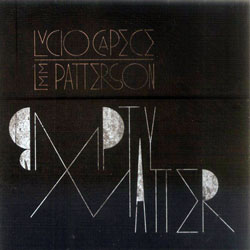
A classically trained guitarist, the only wire strings Argentina-born/Berlin-based Lucio Capece currently works with are those connected from a saxophone, bass clarinet or his beloved s(h)ruti box (an Indian organ) to a feedback unit or "corrupted" mixer: his focus is prepared saxophone, and he is known to extend the bell of the instrument with paper tubes and plastic bottles then plug it up with ping pong balls, water, et cetera. Mancunian sound artist Lee Patterson explores the sonic possibilities and "bizarre beauty" of objects such as cigarette lighters, matches, pinecones, burning hazelnuts and the results of plant-released bubbles on underwater soundscapes (see also his solo Seven Vignettes for further examples); these he magnifies, irradiates and amplifies with custom contact microphones and a Springrod, "a self built instrument constructed from found steel tines (mechanical street sweeper bristles) placed upon a wooden sound box and played with an e-bow."
Though they've wracked up considerable collaborations with everyone from Taku Sugimoto to Phill Niblock to Rhodri Davies to Kevin Drumm (Capece even provided textures for Sasu Ripatti aka Vladislav Delay's Luomo project), Capece and Patterson's meeting for Empty Matter is an equal forum in which the listener is allowed the nuanced delicacy of each musician.
Powering on with a slightly squalling, juicy, sustained motor (is it Patterson's microphone feedback, Capece's reed or a combination?), the two embark on a cautious trek through hushed tones, swelling harmonics, clinking gadgets and purring engines. On "Suspender", they retreat to a minimal hum of near-1 kHz oscillations, Capece injecting a countermelody by intoning above, below and close to the frequency; using echoes, static and a barely-pitched breath-through tubes-into-water approach, the two then shift to "Fervesce", a recreated field recording of babbling brooks and midnight meadow ambience. For "Ventilar", Patterson plucks and vibrates the Springrod, the relatively miniscule chameleon-esque instrument rumbling like rattling radiators, tubular bells and distant carillon. Moving to sruti box on "Sostener", Capece follows his quest for "hidden reactions of permanent sounding pitched instruments" with anesthetic circular bellows that gradually erode — harmonically — upon each union of higher microtonal lodgers.
Together, Capece and Patterson resemble a hybrid Japanese shakuhachi and biwa duo whose success relies on a faithful reproduction of wind and cricket sounds — in other words, eschewing idiosyncrasy to craft an illusion. Of course Empty Matter is more involved, but the experience (attack, patience, sound palette, mood) is sharply related and equally reverent, sacred.
Comments and Feedback:
|



